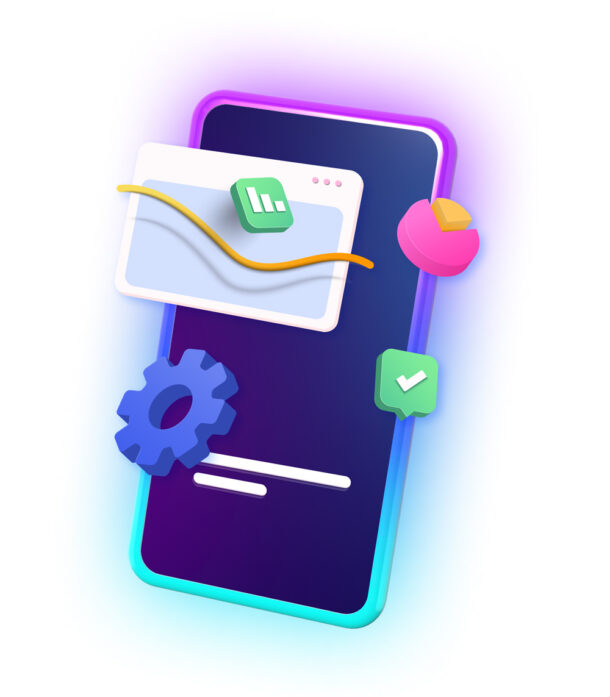Let’s be totally honest.
People don’t like seeing ads. They put up with them.
Display banner ads are probably one of the least favorite types of ads. Users see them as spammy and annoying, so they usually ignore them. Not just on purpose but also subconsciously – aka the banner blindness phenomenon.
For these reasons, marketers are always looking for better ways to engage users. This is where mobile native advertising comes into play.
By reading this article, you’ll discover:
- What mobile native advertising is
- Which types of mobile native ads exist
- Benefits & challenges of mobile native advertising
- Best practices for implementation
- Example of in-game native advertising
The Basics: What Is Native Advertising?
The word “native” stands for something or someone who belongs to a particular place. You were born and raised in NYC? You can call yourself a native New Yorker.
In mobile advertising, the meaning of “native” is not much different.
Native advertising is a form of advertising where ads seamlessly blend with the environment they are placed in. Just like you fit into the environment you’re born in.
Native ads completely match the user experience of the platform they appear in – both visually and functionally. They look and feel like the original content, and users should be able to interact with them the exact same way.
The point of this?
Making ads not feel like ads.
When users interact with native ads, they don’t face aggressive selling of a typical ad. The content of a native ad should be relevant, informative, and entertaining to the viewer. Its purpose is to softly promote the advertiser’s brand and help users understand its value.
About Mobile Native Advertising
Native advertising works with the same user experience concepts on desktop and mobile. Yet, mobile comes with some important distinguishing features.
Mobile native ads are a subcategory of native advertising that appear on the users’ mobile screens. They appear in in-app environments, as well as on the mobile web. This includes everything from social media apps to mobile games and Google searches.
Even though native advertising originally appeared on desktops, today, mobile is much bigger. According to eMarketer, in 2022, native ad spending is almost completely mobile.
Top Mobile Native Advertising Statistics
Did you know that users spend 92% of their mobile time using apps?
With this in mind, it’s no surprise that the majority of native advertising dollars go into different in-app placements.
According to Smartyads, advertisers spend 81% on native ads in mobile apps, compared to 19% on the mobile web.
Out of the time spent using apps, most is spent on social media apps. For this reason, native social advertising is constantly growing – it is predicted to increase by 17.6% in 2022 and by 13.9% in 2023 (Insider Intelligence).
If these stats didn’t hype you up on mobile native advertising, this will.
Native ads have 20–60% more engagement and 3x higher retention rates than traditional display ads (IHS). Also, their click-through rates are 8.8 times higher than in display advertising.
Finally, their impression rates are impressive.
Pun intended.
According to Meta, native ads account for more than 86% of impressions on its Audience Network.
Types of Mobile Native Ads
Native ads don’t come in one shape and size. On the contrary, they come in many forms that are wildly different from one another. In all of its forms, mobile native advertising can be an excellent way for users to discover apps.
Here is a quick overview of the most common types of mobile native ads:
- In-feed ads (social, commerce, and content). This includes sponsored ads in feeds of various social networks, product listings on commerce sites, promoted content on editorial feeds, streaming platforms, etc.
- Social media content. Native ads that appear on social networks, but not necessarily as in-feed content. For example, sponsored Instagram and Snapchat filters.
- In-game and in-app ads. These are mostly opt-in ads (rewarded video, offerwalls) where users are encouraged to watch ads in exchange for rewards. In mobile games, ad units are also frequently blended as elements in the in-game environment.
- In-map ads. When users search maps, eg the Google Maps app, these ads appear as promotions for nearby businesses. They usually provide information like distance, operating times, customer reviews, etc.
- Recommendation widgets. Ads that appear when users interact with similar original content (eg read an article). They come in the form of blocks and are typically labeled “also read” or “recommended for you”.
- Paid search ads. On search engines like Google, paid search ads appear above organic search results and match the query.
Example: In-Game Native Advertising in Subway Surfers
In one of our articles, we analyzed Subway Surfers, the most downloaded game in history.
While playing the game, something caught our attention – native ads for Burger King.
The first type of native ad in the game appeared as an in-game object. More precisely, while players run on the tracks, they can see a Burger King billboard on the side. This is clever because it reflects where we see ads in real life.
Wait, there’s more.
The game also featured an in-game event called the Burger King Challenge. The players who complete the missions in this event could win a special prize – the Burger King character.
As you can see, this game took mobile native advertising to the next level. Native ads are completely blended into gameplay, and potential rewards motivate players to engage with them. Positive reinforcement like this can result in a favorable attitude toward the brand.
Benefits of Mobile Native Advertising
We’ve already mentioned that native ads fight banner blindness and how high their engagement rates are.
However, these are just the first two benefits on a lengthy list.
Here are four additional reasons why you should consider investing in mobile native advertising.
Unintrusive and Valuable Ads
Since mobile native ads don’t look like ads, they don’t come off as disruptive. Nevertheless, it’s not just their looks that attract users.
These ads carry great value.
The thing is, native ads don’t pressure users into taking action ASAP. Instead, they allow them to discover something they might find interesting. For example, mobile native ads frequently address some of the users’ pain points, and how the advertised app helps them solve them.
Next up, users get to process the information they received.
While this might drive some users straight to the app store, others may memorize the app’s benefits and install it in the future.
You Get to Tell Captivating Stories
Stories are a powerful advertising tool.
With compelling storytelling, you can get the users’ attention, trigger curiosity and create an emotional connection. People don’t remember technicalities, they recall how the interaction made them feel.
If you’re wondering if this strategy can work for apps, the answer is yes. However, it heavily depends on your ability to create fun, fascinating, and meaningful stories.
Better Conversion Rates and App Store Rankings
When users interact with a native ad and decide to visit the app store listing, they are usually well-informed about the app.
For this reason, they don’t hesitate to hit the install button.
As a result, thanks to native advertising, apps can get better conversion rates in the app stores. Not only that, but mobile native advertising can even improve your app store rankings.
How?
Conversion rates are one of the key factors determining app store rankings. If the app store recognizes that most users who visit your app listing install the app, this should consequently increase your ranking.
Targeting Potential
Native ads usually appear on platforms where users are most likely to find them interesting.
For example, it’s positive if the host app and the advertised brand have similar user demographics, or if they gather people with similar interests.
When users see content relevant to them, they are more open to it. This is also one of the reasons why native ads have such high click-through rates.
Challenges of Mobile Native Advertising
Despite a long list of benefits, mobile native advertising is not all rainbows and unicorns.
It comes with certain challenges.
Time-Consuming Process
Finding a well-performing native advertising strategy is challenging. In order for your native ads to work well, you need to create content that adds value to the user.
Unlike native ads, banners are known to be cheap and easy to produce. They can be set up with a few bits of information from the advertiser, and they’re ready to go.
On the other hand, native ads usually require deeper customization. It doesn’t matter if they come in the form of an article, a survey, in-game content, or something else. If you want your native ads to be successful, you’ll need to do the double work of creating the content and carefully adapting it into the placement.
You need to be aware that this will cost you some time and money. But rest assured – ultimately, the results will make it all worth it.
To achieve the desired result more quickly, make sure to choose an expert partner. We at MAF can help you find the best match between your app and users in the shortest time frame possible.
Fighting Deception
It’s no secret that native ads are meant to differentiate from ads. This is not just a benefit of native ads, but a potential drawback too.
As an undesired effect, native ads can make users feel tricked into engaging with an ad. If this happens, they can develop negative feelings toward your brand.
Luckily, you can prevent this from happening.
As long as you’re transparent about the nature of your content, you should be fine. Again, finding the perfect way to do this will require some time and testing.
Performance Measurement
Measuring ROI and performance for native ads is a challenge of its own. It would be unfair to define the success of a native ad by the number of clicks and conversions it delivers.
In native advertising, experience and engagement are more important than conversions.
Don’t worry, don’t have to deal with this challenge on your own. This is an important area where top mobile native ad networks like MAF come to the rescue and provide you with the assistance you need.
Best Practices for Mobile Native Advertising
What separates a great native ad from an average one?
To help you answer this important question, we’ve compiled a list of best practices in three separate areas of native advertising.
Design & Content
- Use fonts and colors that fit the surrounding
- Match the tone, structure, and content of the environment
- Camouflage, but don’t make it deceptive
- Don’t make your content larger than the original one
Placements
- Make sure the ads don’t disrupt the user experience
- Native ads should never take over the users’ entire screens and be closed manually
- Analyze the user journey to determine where and when to display the ads
Strategy
- Make sure your ads don’t deceive users and establish trust
- Test various ideas and elements to find out what works and what doesn’t (design, copy, CTAs)
- Experiment with different placements
- Monitor how your ads are performing and plan updates accordingly
- Combine native advertising with other types of mobile advertising
Wrapping up on Mobile Native Advertising
That’s it, these are some of the most important things you should know about mobile native advertising.
Are you interested in launching native ads but don’t wait forever to get results? We would be happy to have a chat with you. MAF can help you grow your app’s native advertising, and as a result, scale your business.







